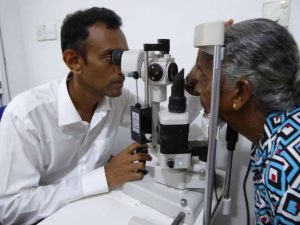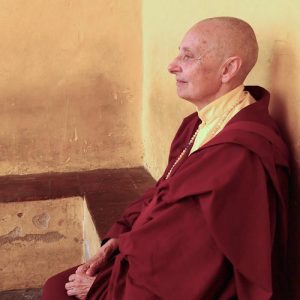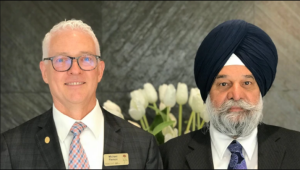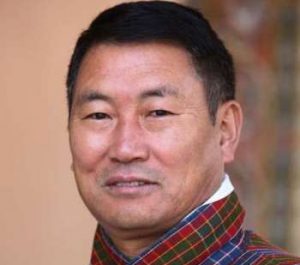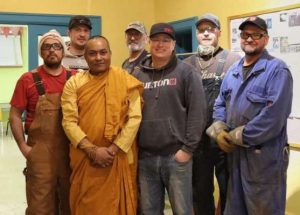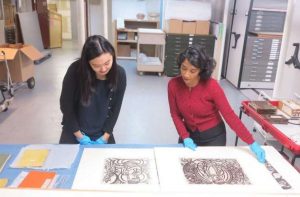
This two-part article is directly inspired by personal visits to Unmun-sa, a historic Buddhist monastery and training college for female monastics in South Korea. These visits resulted from interacting and practicing with the lay sangha of Jungto Society, a volunteer-based Buddhist community founded the Korean Dharma master and social activist Venerable Pomnyun Sunim, and through participation in the 18th Sakyadhita International Conference, held in Seoul from 23–27 June this year.
The first in-person Sakyadhita conference since 2019 because of the COVID-19 pandemic, the 2023 forum in Seoul was held under the theme “Living in a Precarious World: Impermanence, Resilience, Awakening”—the largest gathering in the history of Sakyadhita, jointly hosted by the Korean Bhikshuni Association and Sakyadhita Korea. More than 3,000 Buddhist monastics, laypeople, guests, and dignitaries from different countries and Buddhist traditions were in attendance, sharing their experiences and research, and providing support and encouragement for projects and initiatives to improve conditions for Buddhist women—especially those living in developing countries.
This two-part article is part of a series that explores unique manifestation of the sacred feminine in contemporary Buddhism, by meeting and learning from some of the women who are working to shape the face of Buddhism today. Part one of this article provided an overview of the role and history of Unmun-sa in Korean Buddhism.* Part two, presented here, centers on a candid conversation with two members of Unmun-sa’s monastic community: Venerable Jin Gwang Sunim, a senior sangha member who holds PhDs in Buddhist philosophy and Buddhist art history, and has a special interest in cultural heritage; and Venerable Dong Woo Sunim, who is in charge of first-year bhikshunis at Unmun-sa and specializes in translating sutras from Chinese into Korean. The venerables shared insights about the lives of female monastics in Korean Buddhism, their work, and the challenges that they face.
BDG: Did you grow up in a Buddhist family before deciding to follow the path of monasticism?
Ven. Jin Gwang Sunim: My uncle was a Buddhist monk, which I was very aware of growing up. But it was in high school when I became very interested in Buddhism. I couldn’t really find anything that I could engage with in the secular world. I was the founding member of a small community of people who wanted to pursue Seon [Zen] meditation. Each week I would go to Jogye-sa, the head temple of the Jogye Order of Korean Buddhism, in downtown Seoul to practice 공안 (Kr. gong-an [koan]) meditation. And there I also received books from which I studied Buddhist philosophy.
After graduating from high school, I went to work in a bank. And it was during this period that I had the opportunity to meet the respected monk Ven. Kuan-in, and I was lucky enough to attend his Dharma talks, which he gave once a month at Daewonjeong-sa, a monastery in Gyeonggi Province. One of his teachings that really resonated with me came from the Flower Garland Sutra [or Avatamsaka Sutra], and describes the mundane secular life in which we keep counting other peoples treasures, but leave none for ourselves. And that was literally what I was doing, because I was working in a bank—I was counting money for all these other people, but I had none for myself!
The next stage, was when I went to Bujang-sa, a temple in Anyang Province, near Seoul, to explore whether I could enter monastic life. And from there I was introduced to Ven. Myeongsong Sunim, who has been the head monastic at Unmun-sa since 1970.
I think that from the beginning, my personal values were already aligned with the core values of Buddhism. I wasn’t really enjoying secular life—talking to friends, living the so-called “good life,” and so on—and that helped to encourage me on this path.
Ven. Dong Woo Sunim: I didn’t have any spiritual or religious upbringing at all! However, growing up, I found that I had very different values from those around me and I spent a lot of time trying to find a balance between the values that I thought were worth pursuing, such as a peaceful society, compassion, being kind to each other, and all the materialistic ways of the world that seemed to be the norm everywhere.
I was interested in traveling, which brought me into contact with many Buddhist temples. There’s a famous book in South Korea that deals with all the famous national treasures, many of which are Buddhist, and places worth visiting, and that’s where I found my introduction to Korea’s Buddhist temples.
I was also very interested in contemporary social issues. And for some years after I chose to become a monastic, I often wondered what might have happened if I’d thrown myself into working for worthy social causes. But it’s already been more than 25 years since I embarked on this path, so I think I’ve made peace with that choice!
BDG: How old were you when you finally decided to be ordained as a monastic, and what was your main motivation?
Ven. Jin Gwang Sunim: I was 20 years old when I was ordained. Things were a little different back then, and we didn’t need to undergo the four years of formal training.
It seemed like everything just fell into place for me when I chose to become ordained. There were those big questions: Who am I? What are the things that are important to me? What’s worth pursuing in this life? And I remember thinking to myself that they couldn’t have been any other way for my life to unfold. Although I might sometimes have felt tired, my spirit was always very happy, and I kept encountering small miracles that helped me along the way to being ordained.
There was the issue of my parents. They weren’t entirely on board with my decision and they had a lot of expectations for me in life. And that became a major driving force behind my motivation: thinking about my parents, I couldn’t afford to be lax in my practice.
BDG: That must have been a considerable obstacle on your path?
Ven. Jin Gwang Sunim: By this time, I was able to completely turn it around and make it a driving force behind my motivation. I was confident that I would be better able to repay my parents by keeping to this path, rather than complying with their wishes and pursuing the “good life” that they had expected of me.
Ven. Dong Woo Sunim: It was a bit different for me, because I didn’t really know what to expect when I first became a monastic. I had some sense of what was involved, but that can only take you so far. As the years went on, and I learned more about Buddhism, I began to realize more and more that this was something that was worth dedicating my life to. I had been a student of literature, but I found that Buddhism offered something that I was unable to find in secular life. As might be expected for a serious student of literature, I suffered from a massive ego! And Buddhism offered a direct escape route out of that.
So I told my friends at the time: I’ll see you in 10 years; let’s see what happens. But after 10 years, I didn’t go to meet them. And that’s when I was able to say with confidence that I had chosen the best path for my future.
BDG: And now how many years have you been bhikshunis?
Ven. Jin Gwang Sunim: 42 years!
Ven. Dong Woo Sunim: 23 years.
BDG: How well are female monastics accepted in Korean society, compared with the past and compared with male monastics today?
Ven. Jin Gwang Sunim: Compared with how people used to think about female monastics back then, in the 1970s and 1980s, there was a tendency for people to think that monasticism was for women who had encountered major obstacles in life and so they were forced to choose this path—there was a stigma: they had failed at something; there was a failed love affair; their parents had disowned them; or their family was too poor to support them. These are the kind of perceptions that people had in those days of women who became monastics.
But this perception has changed over the years, especially after the late 1980s and 1990s, when Korean bhikshunis were able to receive more education, had more social status—both inside and outside of the Jogye Order of Korean Buddhism. And things also changed within the order itself. Bhikshunis were now able to teach their own students. Before, female monastics had to learn from the monks, but that changed and ordained bhikshunis were able to make greater progress outside of the order in many aspects of Korean society, such as education, culture, social welfare, and so on. And also in the arts.
BDG: There is a sense of a mutual respect within the Jogye Order sangha?
Ven. Jin Gwang Sunim: I guess you can apply the same evolution when it comes to the matter of equality within the Jogye Order. It’s not supposed to be that way, but everyone knows that there are fewer female than male monastics when it comes to administrative roles at the higher levels. And there are around 26 head temples in South Korea, each of which is in charge of all the temples in a particular region, and they are all run by male monastics and none by female monastics. So there’s still a lot that can be said about this situation!
Although there are roughly the same number of monks and nuns in Korea, the kinds of opportunities that are available to them, especially after graduation from traditional education, such as is provided at Unmun-sa, there is a wide disparity between monks and nuns. Bhikshus have a lot more options as to where they can go, meditative practices, undertaking many kinds of administrative work within temples, and so on. We are given fewer choices.
BDG: Do you think this is changing, albeit slowly?
Ven. Jin Gwang Sunim: It is changing, but so far it’s not enough.
Everything is relative, of course. Compared with Taiwan—I haven’t been there, but my colleagues have—from what they’ve seen, compared with temples such as Unmun-sa, where the bhikshunis run the whole thing, it’s very different in Taiwan. The bhikshunis are widely known there as leaders and agents of change in their own societies, doing lots of welfare work and so on, but the concept is that they still work under the monks. So in that respect, Korea seems to be freer somehow.
BDG: Roughly how many monastics are there in South Korea today?
Ven. Jin Gwang Sunim: For female monastics there are around 6,000 within the Jogye Order only, and a similar number of monks. But of course, there are many other Buddhist orders in Korea. Among new monastics, there were more sramaneris [female novices] than sramaneras [male novices] a decade ago, but the numbers have since reversed and there are more sramaneras these days, although the numbers for both groups are declining. At Unmun-sa now, there are about 70 bhikshunis. Less than 10 years ago, there were 250.
All the traditional sangha colleges are suffering the same fate, with declining numbers of monastics. But we still have the largest number of bhikshunis-to-be, with about 50 sramaneris. We receive around 10 or so new recruits every year, which is still higher than we were expecting.
BDG: Does the sangha in Korea have strong ties with female monastics in other countries?
Ven. Jin Gwang Sunim: We do have official ties with some external institutions. For example, Unmun-sa has sister institutions in Japan, China, Thailand, and so on. But I think that we could be more active in cultivating these connections. At the individual level, there are many such relationships. After four years of formal education and then ordination, Korean bhikshunis are free to pursue activities in countries such as Thailand, Vietnam, Myanmar, and so on. But at the official level, there isn’t that much.
BDG: I’m wondering whether female monastics in Korea or at Unmun-sa could play a role in helping women in countries such as Thailand, where they have difficulty ordaining in their own tradition?
Ven. Jin Gwang Sunim: I guess there has yet to be a formal agreement across the Jogye Order itself for these kinds of things to happen with any kind of viable momentum. This is because there are various factors to consider. For example, there was a historic occasion in 1996 when monks and nuns from Korea went to India to ordain 10 or 11 women from Sri Lanka, but that momentum hasn’t been sustained. Right now, however, we are at a point where any kind of individual action can be seen as having more influence than it used to have.
I would say that we need some kind of dialogue to take place, some kind of agreement to be reached before any individual in the Jogye Order can be expected to act with any degree of freedom or certainty. It’s quite a political situation!
But because there are things happening, there is at least an awareness and consensus across the Jogye Order itself that these things need to happen and we can help, so why not? But it might take some time before we see the results that we want.

BDG: Do you have any aspirations for the future that you’d like to share, or is there anything that we haven’t talked about that you’d like to people to know?
Ven. Jin Gwang Sunim: My personal plans for the future involve doing what I’ve always done: studying and teaching the Dharma. I wish to live a life where I can be satisfied with having less and wanting less. And I hope that I can play a role in bringing the Dharma to more people, for a more peaceful world and a richer spiritual life for everyone.
Up until now, my monastic life has had a strong focus on personal Dharma study and personal Dharma practice. Lately I’ve become increasingly aware that fewer and fewer people are willing to try out this monastic lifestyle. Although this situation has ties to other social factors, such as declining birth rates, I think that perhaps the monastic sangha has not been able to present the kind of alternative life that’s possible for people to consider seriously. So a major objective for me is to reflect on this and find out what we can do about it!
BDG: Ven. Jin Gwang Sunim, Ven. Dong Woo Sunim, thank you both very much for your time!
* Daughters of the Buddha: Unmun-sa, a Wellspring of Bhikshuni Ordination in South Korea, Part One (BDG)
See more
운문사 (Unmun-sa)
18th Sakyadhita International Conference: Living in a Precarious World: Impermanence, Resilience, Awakening
Sakyadhita International Association of Buddhist Women
Related features from BDG
Daughters of the Buddha: Unmun-sa, a Wellspring of Bhikshuni Ordination in South Korea, Part One
Daughters of the Buddha: From Banking to Buddhism – A Conversation with Gelongma Pema Deki
Daughters of the Buddha: Progress on the Path of Female Ordination – A Conversation with Ven. Dhammananda Bhikkhuni
Daughters of the Buddha: Buddhism and Film with Ven. Daehae Sunim
Daughters of the Buddha: 18th Sakyadhita Conference in Seoul Celebrates the Sacred Feminine
From Bangladesh to Korea: Struggles and Successes on the Path to Female Monasticism
From Bhutan to Korea: Reflections of a Female Monastic on the Buddhist Path
Buddhistdoor View: Experiencing the Phase Shift – Women in Buddhism Today
Related news reports from BDG
Tibetan Nuns Project Announces a Record Number of Buddhist Nuns Taking Geshema Examinations in Dharamsala This Year
Living in a Precarious World: 18th Sakyadhita Conference Commences in Seoul
Engaged Buddhism: 20th Biennial INEB Conference Commences in South Korea














